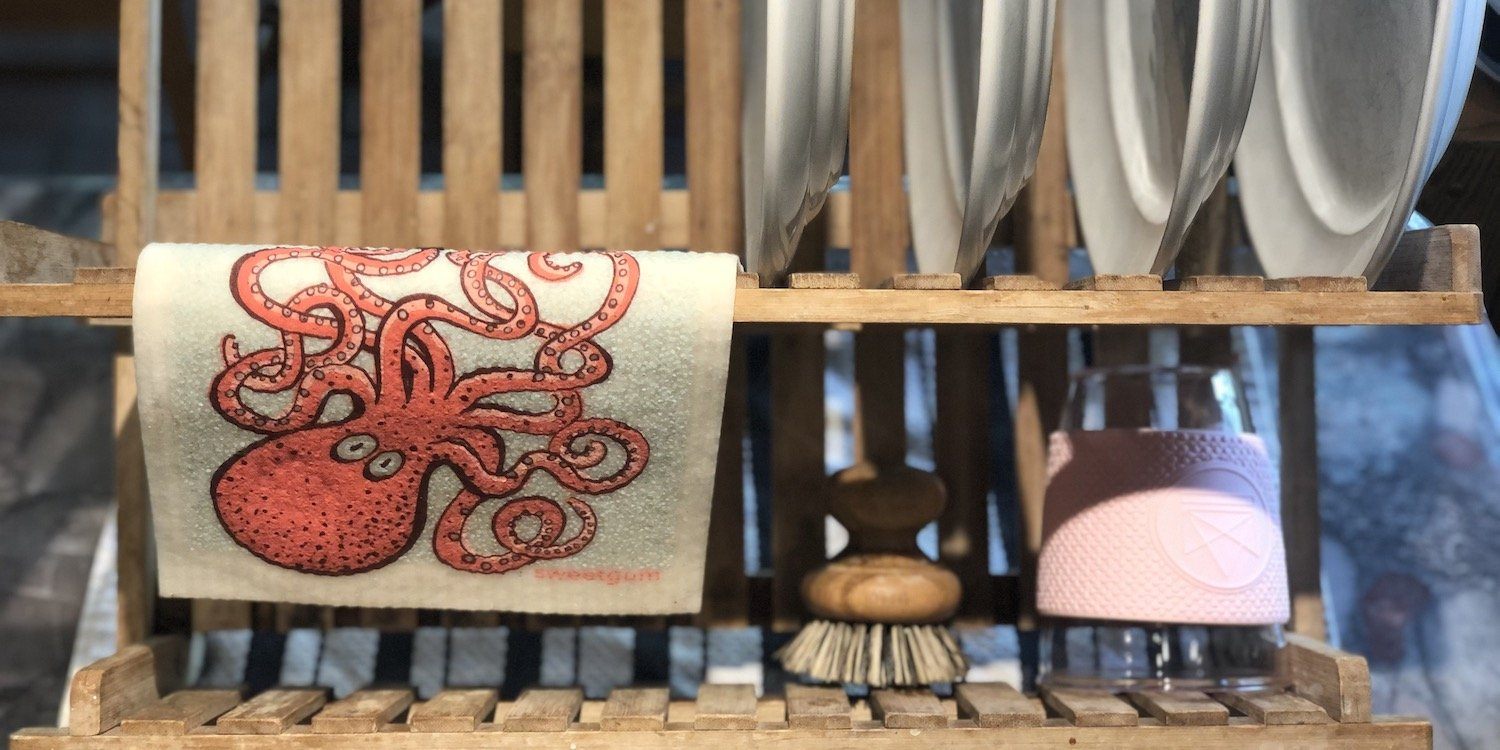Starting out on a sustainable fashion journey is rarely straightforward.
At first, it may seem straightforward: you decide to stop buying fast fashion and support sustainable brands instead. Then it gets a little more complicated: you realize some of your favorite brands are participating in greenwashing by exaggerating their support of people and the environment and doing little to create real, tangible change. You then travel down a rabbit hole where you discover that other sustainable brands, even if they aren’t greenwashing, are still using resource-intensive materials, haven’t eliminated plastic from their packaging, or aren’t as transparent as they need to be.
By this point, if you’re not tempted to give up and return to your old buying habits, you may decide to stop buying new clothing from fashion brands altogether, sustainable or not, and instead fill your wardrobe via a different method: thrifting.
The good in shopping secondhand:
Thrifting seems like the safest and easiest way to make sustainable fashion choices. It’s great for the environment because it extends the life and circularity of clothing, and it’s certainly more affordable than buying new pieces from sustainable brands. Thrifting no longer carries the stigma it once had, partially thanks to social media platforms like TikTok, which allow users to share videos of themselves modeling the trendy clothing they bought secondhand. At this rate, the secondhand market is predicted to be about twice the size of fast fashion by the end of this decade, thanks to Gen Z.
A quick Google search for “cons of thrifting” turns up only surface-level disadvantages: the clothes might smell bad, more work is required to find fashionable pieces, and thrift stores often have no return policy. If you’re truly concerned about sustainability, however, these minor setbacks are probably nothing compared to the moments of reckoning you’ve faced at other points in your ethical fashion journey.

After all, the only truly sustainable piece of clothing is the one that’s already in your closet, right? By extension, the second most sustainable piece of clothing must be the one that’s thrifted–the piece that leaves someone else’s closet and travels to yours with, of course, a quick pit stop in between.
If only it were that simple.
The bad in shopping secondhand:
In this episode of the Ethical Fashion Podcast, co-host Simone Cipriani comments directly on the expectation that the most sustainable piece of clothing is the one hanging in your closet: “This is true from the point-of-view of the [physical] environment. The human ecosystem is made from the physical environment and the social environment. And in the social environment, you need work. If you remove all production, if you remove all these kinds of experiences from all the countries that need work and production, the social environment collapses.”
In other words, thrifting may be a wonderful,environmentally sustainable option, but is it socially sustainable?
Buying clothes secondhand is one way of withdrawing support from unethical brands, but it does nothing to provide new support to the people they’ve exploited. One of the biggest issues with fast fashion is the exploitation of garment makers. Workers are commonly underpaid and overworked in conditions that threaten their health and safety. Part of the goal is to stop bankrolling brands that participate in this exploitation, but their employees still need jobs that will allow them to comfortably support themselves and their families, albeit with better working conditions and higher pay.

On the other hand, most sustainable fashion brands, while imperfect, are focused on paying livable wages to the people that make their clothing. Movements like the Lowest Wage Challenge hold these brands accountable for paying livable wages (beyond the minimum), and certifications like Fair Trade ensure that their products are made in safe and clean working environments. When it comes to social sustainability, buying new may have the upper hand–as long as the brands you’re buying from are making conscious efforts to care for their employees.
Thrifting can also be problematic in more local environments. On this episode of the Conscious Chatter podcast, environmental educator Isaias Hernandez addresses his concerns about the gentrification of thrifting, which he defines as “the lack of affordable, fashionable clothing for lower income communities of color.”
This issue is complex and multifaceted, but it’s exacerbated by higher income people who choose to buy clothing from thrift stores even though they could afford to buy new clothing from eco-conscious brands instead. This includes younger generations, like Gen Z, who view thrifting as a trendy way to acquire unique pieces of clothing. Even if they (or their parents) can afford to buy new, they may find thrifting more appealing for its environmental benefits and the chance to find a vintage piece that no one in their friend group will have. According to the Berkeley Economic Review, this may lead to “less quality items left on the thrift store shelves for those who truly have no other affordable options, say, for buying professional attire that could mean the difference between impressing or crashing at a job interview.”

Hernandez also discusses the fact that people don’t always shop at thrift stores to fill their own closets–sometimes the intention is to resell items for a higher price. This practice is made easier by “closet cleanout” apps like Depop and Poshmark, which are excellent mediums for finding affordable, curated pieces of clothing. Many people use these apps to sell old clothing they already own and no longer need, but others rake through thrift stores for the most desirable pieces of clothing, then turn them around for a profit. Resale isn’t innately bad, but it does drive up the prices of secondhand clothing, potentially making it less accessible to the low-income people it was originally meant for. This disproportionately affects Black and Hispanic households because of their overrepresentation in national poverty levels.
It’s worth noting that this issue has little to do with theamount of clothing left behind; thrift stores usually have plenty of inventory. They have so much, in fact, that only about10-20% of the donations they receive end up on their shelves. Instead, the problem here is that these practices make it increasingly difficult for lower-income people to find fashionable, quality clothing in the sizes that they need.
So is thrifting good, or is it bad?
Maybe asking this type of question is the wrong approach to sustainability. When it comes to ethics, there is very little in the world that is uncomplicated or black-and-white. Most of our actions fall somewhere along a spectrum of “right” and “wrong,” and while there may be certain behaviors that fit nicely on either pole, the majority exist in the grey area in between.
In fact, the issues that arise with thrifting can be broken down further to create an even muddier middle ground. For example, if the people who scour thrift stores for resale are lower income, and the extra money is necessary to put food on their table, is it still an issue? If you come from a higher income background and have access to financial support, but you don’t have much money of your own, is it still an issue?

There are no hard and fast answers to these questions, and there is no perfect way to live a sustainable lifestyle. It’s possible that thrifting falls at different points on the spectrum for different people; it may be the best option for one person while simultaneously being a less ethical choice for another. Thrifting every piece of clothing you own might not be the best route, but avoiding thrifting altogether isn’t much better.
Can we support imperfect brands with a clear conscience?
While it’s true that most sustainable brands will probably fall short in one area or another, we can applaud them for every step theydo take in the right direction. Most are working hard to improve the physical environment of the earth and the social environment of their employees, and their efforts are positive steps toward change–especially if we, as consumers, continue to hold them accountable for their actions.
A sustainable lifestyle is best supplemented by a sustainable mindset; we should ask questions, think critically, and be open to change. Rather than placing a cut-and-dry judgment of “good” or “bad” on the practices that we (and others) participate in, we can approach our choices with nuance and understanding. Grey areas can be uncomfortable, but each choice we make has its own benefits and setbacks. Declaring one action to be better than another doesn’t do the big picture justice.

Finding the balance in our practices may take a little bit of work, but it’s worth it. After all, each individual piece is necessary to create a sustainable whole.






